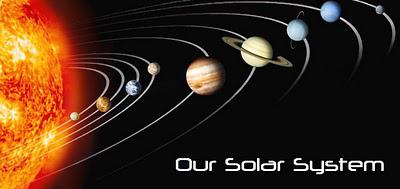The Solar System consists of the Sun (a star of medium size within the Milky Way galaxy) and the bodies orbiting around it: 8 major planets, at least 171 planetary satellites, countless asteroids and comets and the enormous inter-planetary medium. Four large planets have a ring system, while the six of them has one or more satellites. Several thousands of minor planets or asteroids, mainly circulating in an orbit between Mars and Jupiter (Asteroid Belt), while most of the billions of comets travel around the sun in a spherical shell about 50 000 times farther than the Earth. Inter-planetary medium (extremely rare plasma or ionized gas permeated by fluff) extends to large distances from the Sun.
The sun, which contains 99% mass of the solar system is located in its center, while all the planets (and asteroids), moving around the sun in an elliptical orbit that is in the direction of rotation of the Sun. Venus and Neptune have most circular path, while the inclination (the angle that the planets closes with orbital plane) is the largest at Mercury 7 ° and Pluto 17 °. Many other physical characteristics can be determined using the distances and dimensions of the planets. Knowing the diameter and mass of the planets, astronomers can calculate its density or mass per unit volume, which allows them to create proposals on their composition. The planets can be divided into two groups according to their density. These are the inner planets (Mercury, Venus, Earth and Mars), who have a rocky composition and density greater than 3 g/cm3, and external (Jupiter, Saturn, Uranus and Neptune), whose density is less than 2 g/cm3 and they have gas composition. Pluto is unique because it was icy, with low-density his body is smaller than Earth's moon, and most resembles
on a huge comet's nucleus or satellite of an outer icy planets.
The relatively small inner planets have solid surfaces, no system of rings, and with few or no satellites. Atmosphere of Venus, Earth and Mars contain a substantial amount of carbon dioxide (CO2). In the inner solar system only Earth has a magnetic field (magnetosphere) that protects the planet from radiation from inter-planetary medium. The outer planets are much more massive, with an atmosphere composed mainly of hydrogen (H) and helium (He). They have no solid surface, and their density is so low that as example, Saturn would be floating on the water. Each outer planet has a magnetic field, the ring system and a large number of satellites. Pluto is again an exception without a ring but with three satellites.

More than 170 satellites is a great diversity of the environment. Io orbits around Jupiter, with destroyed body of intense volcanic activity, while Saturn's largest satellite Titan has a primitive atmosphere thicker than Earth's. Triton is in a retrograde (opposite direction of rotation of most of the bodies in the solar system, ie. clockwise motion) orbit of Neptune and has a surface temperature of only 37K (-236.15°C).
Asteroids and comets are remnants of the process of creating a planet in the solar system. Asteroids are rocky bodies whose sizes may be from the largest known asteroid Ceres (about 930 km diameter) to microscopic spread out in the asteroid belt. Collision of an asteroid 10 km in diameter can have devastating effects, such as it is considered that happened at the turn of the Cretaceous-Tertiary, which led to the extinction of dinosaurs. Physical characteristics of comets are completely opposite properties of asteroids. They consist mainly of ice: frozen water (H2O), carbon dioxide (CO2), carbon monoxide (CO) and other forms of ice. These icy cosmic dust balls are covered with rich organic content. Typical comets have an irregular shape with a core diameter of several kilometers. Most of their lives on the third of the distance from the Sun to the nearest stars in the so-called Oort cloud of comets (Jan Oort - Dutch astronomer).
The most famous comet Halley belongs to the short-periodic comets (those comets whose orbits shortened close encounter with Jupiter on its way from the Oort cloud to the sun) with a period of just 76 years, unlike a few million other comets with a period of several million years, and has a retrograde orbit relative to the Sun. As comets approach the sun, they are increasingly losing material when sections of Earth's orbit around the sun causes a meteor "rain" which significantly increases the amount of meteors, it is interesting that during a normal day on Earth falls about 400 tonnes of asteroidal and comets debris.
